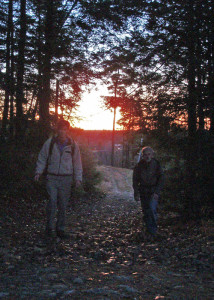
No matter what “night people” like my son Justin will tell you, human beings aren’t nocturnal. Compared to truly nocturnal critters, we are poorly equipped: our eyes are small and not designed for optimum low-light viewing. We are designed to sleep at night, be active during the day.
It seems that most of us are having to work longer and harder these days just to stay even. At this time of year, that often means being at work when the sun’s just rising and coming home in the dark. When do you find time for getting outdoors and having fun?
Your weekends are already full and even if you spend both days outdoors, two days a week for having fun is not enough.
What about nighttime fun outdoors? If you can get outdoors comfortably and safely after work, you’ve just increased your opportunities to enjoy the outdoors seven days a week.
At this time of year, night hiking can get you out and moving after the sun sets. When it gets a little colder, you’ll be able to add skating, sledding, snowshoeing and cross-country skiing to the mix.
To enjoy being out in the evening you have to dress for the inevitable chill. Several recent columns have pretty well covered (pardon the pun) the subject of dressing properly for outdoor activity, with advice on base underwear layers, insulation and shell garments, and keeping head, hands and feet warm .
Moving safely in the dark is another matter. It makes sense to carry a light with you on any night outing, but don’t assume that you are going to use it all the time. With electric lights that can be flipped on and off at will (except in the aftermath of last-year’s ice storm . . .) we’ve forgotten that, most of the time, you can see quite well at night from moonlight, starlight and, unfortunately, the light pollution that scatters about the atmosphere.In fact, unless there are heavy clouds or you are walking beneath a heavy canopy of evergreens, after you’ve given your eyes a chance to really adjust to the dark, you won’t need or want a light—the night is more magic without one.

On most nights, you should easily be able to see at least well enough to walk on open ground. Here’s a trick: You actually see better in the dark when you don’t look directly at something. Try to keep your eyes moving side-to-side, or look above where you are going to step. It works.
The last two evenings, my son Justin and I have strolled (OK, he’s strolled, I’ve huffed and puffed . . .) up a nearby ski hill to watch the sunset. It really wasn’t much of a hike, but it was enough to get our lungs working and our blood and conversation flowing. The glow of the setting sun over nearby hills was brilliant orange; the lights in the valley twinkled as we walked down in nearly total darkness. By the time we got down, we were de-stressed and ready to enjoy the evening.
Nighttime Fun Outdoors: Nature’s Night Lights
The moon is always a perfect excuse to get out for a night adventure. Hare’s a e moon phase calculator for virtually any date, but it’s all in Universal Time, so you’ll have to do some math. Do yourself a favor and plan a full moon walk or ski or skate sometime this winter.
On nights when there isn’t a moon, the stars shine brighter. Check out the latest viewing info at stardate.org.
But the best of all of Nature’s nightlights is the Aurora Borealis—the northern lights. Unfortunately, it’s not completely predictable when it will come to visit us, but when it does, you simply have to get out and see it. In Labrador and Nunavik (northern Quebec), I’ve seen it bright enough to read by.
This Aurora forecast website has predictions on when you might see the aurora. Click on the North America map in the upper left corner. It’s telling me that my friends in Kuujjuaq are enjoying the show right now.
Google “Aurora borealis” for some fabulous images. But you haven’t seen the Aurora until you’ve stood outside on a frozen wilderness lake, on a bell-clear moonless night.

Nighttime Fun Outdoors: Glow to Go
If you’re getting serious about night walking or biking, get an LED headlamp. Unlike a flashlight, a headlamp naturally points where you are looking and leaves your hands free.
There are lots of good headlamps on the market these days. Just make sure you choose one which takes batteries that are easy to find and easy to remove and replace in the dark . . .
I’ve been using Princeton Tec headlamps for years, largely because they are inexpensive, compact, comfortable to wear, and utterly reliable—which is what you want in a headlamp. A couple of years ago, they came out with model called the Aurora which ran almost forever on three AAA batteries. I thought it was the best all-around headlamp that anyone could possibly invent.
Then, they came out with a new model called the Fuel with three ultra-bright LEDs. Again, three AAA batteries but more compact, even brighter and it seems, even more efficient. Now they’ve brought out two new versions of the Fuel, one with four white LEDs—even brighter than its predecessor and one called the ReMix, with three red LEDs and one ultra bright white LED.
I wasn’t certain I’d like the red LEDs — they aren’t good for lighting up a general area (that’s what the white LED is for). But they are truly wonderful for night walking since the red light lets you see everything on the ground in front of you so you won’t stumble, but it doesn’t affect your night vision as much, so there’s more to see by moon and starlight.


